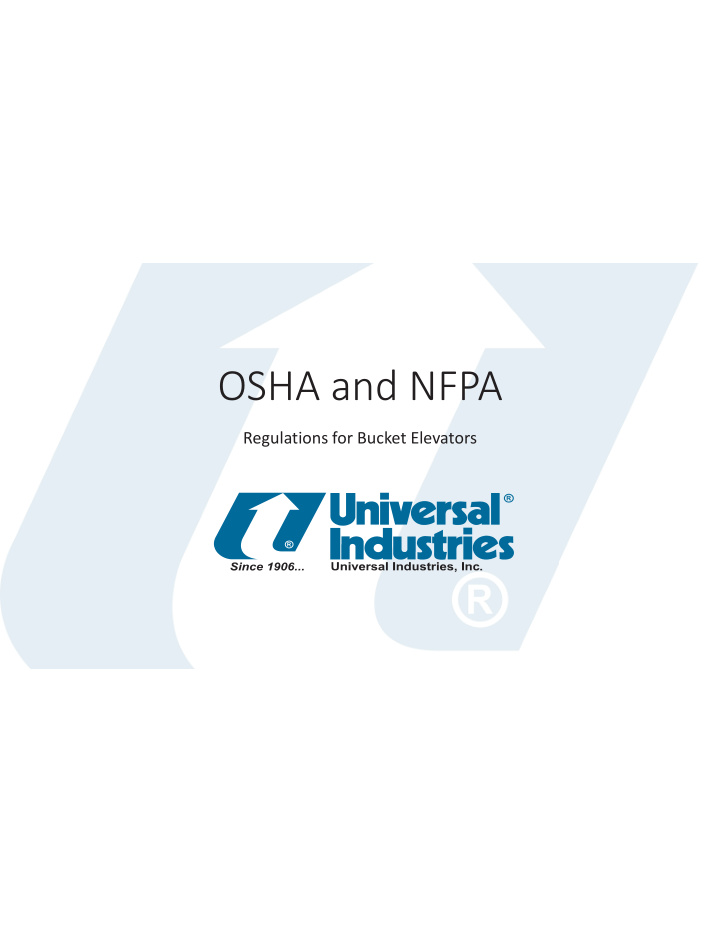



OSHA and NFPA Regulations for Bucket Elevators
OSHA Pre 2017 1910.27(d)(1)(i): “Cages or wells (except as provided in • subparagraph (5) of this paragraph) conforming to the dimensions shown in figures D-7, D-8, and D-9 shall be provided on ladders of more than 20 feet to a maximum unbroken length of 30 feet.” 1910.27(d)(2): “”Landing platforms.” When ladders are used to • ascend heights exceeding 20 feet (except on chimneys), landing platforms shall be provided for each 30 feet of height or fraction thereof, except that, where no cage, well, or ladder safety device is provided, landing platforms shall be provided for each 20 feet of height or fraction thereof. Each ladder section shall be offset from adjacent sections. Where installation conditions (even for a short, unbroken length) require that adjacent sections be offset, landing platforms shall be provided at each offset”
OSHA 2017 and Beyond:
OSHA 2017 and Beyond Cont.: Up to November 18, 2018 After November 19,2018 • 1910.28(b)(9)(iii) : “ The 1910.28(b)(9)(i)(B) : “New • employer must ensure fixed ladders. Each fixed ladder sections having a ladder installed on and cage or well:” after November 19 th 2018, 1910.28(b)(9)(iii)(A) : “ Are is equipped with a • offset from adjacent personal fall arrest system sections; and” or ladder safety system” 1910.28(b)(9)ii(B): “The • 1910.28(b)(9)(iii)(B) : “ Have • landing platforms provided ladder has rest platforms at maximum intervals of 50 provided at maximum feet.” intervals of 150 feet.”
NFPA 61 Elevator Head Section A. The head section shall be as dust tight as practical (8.3.1.1) B. The head section shall have inspection openings for head pulley lagging, belt and pulley alignment, and discharge throat (8.3.7.1.3) C. Each leg shall be independently driven and capable of starting un-choked leg at 100% capacity (8.3.7.1.4- 8.3.7.1.4.3) D. Limit the use of plastic, rubber, and other combustible linings to high impact areas (8.3.7.1.6) E. The section between the up and down leg section in the head shall be sloped at an angle not less than 45 o (8.3.7.1.7) F. The head pulley shall be lagged with a surface resistivity not greater than 100 megohms per square inch (8.3.7.9- 8.3.7.10) G. Vent(s) in the head must be on the top surface or sides using a method to deflect the explosion upward. The minimum vent area required is equal to 5 ft 2 per 100 ft 3 of head section volume (8.3.7.2.2.7)
NFPA 61 Boot section A. The boot shall be as dust tight as practical (8.3.1.1) B. The boot section shall have inspection openings for cleanout and inspection of the belt and pulley (8.3.7.1.2) C. Limit the use of plastic, rubber, and other combustible linings to high impact areas (8.3.7.1.6)
NFPA 61 Intermediate sections, Belting, Buckets, spouting, and monitors A. The intermediate sections shall be as dust tight as practical (8.3.1.1) B. Limit the use of plastic, rubber, and other combustible linings to high impact areas (8.3.7.1.6) C. All spouts shall be designed to handle the full rated capacity of largest elevator in system (8.3.7.1.8) D. Belts shall have a surface resistivity not greater than 100 megohms per square inch (8.3.7.1.10) E. Belts shall be fire and oil resistant (8.3.7.1.11-8.3.7.11.3) F. Inside legs shall have bearing temperature, or vibration detection sensors (8.3.1.12.1) G. Inside legs shall have belt alignment sensors at the boot, head and knee pulley if equipped (8.3.7.1.12.2)
NFPA 61 Venting A. Side vents on intermediate sections shall have a minimum area equivalent to two-thirds of the cross-sectional area of the casing (8.3.7.2.2.4) B. Single faced vents permitted under special circumstance and shall consist of four-thirds the cross-sectional area of the leg casing (8.3.7.2.2.5-8.3.7.2.2.6) C. Newly installed outside legs shall be provided with explosion relief panels located at intervals no greater than 20 feet (8.3.7.2.2) Legs handling bulk raw grains: D. Explosion relief panels shall start between 8-12 foot above grade or the bot of an explosion panel shall be within 1-4 foot after the leg penetrates the building roof (8.3.7.2.2.1- 8.3.7.2.2.2) E. Venting is not required on portions of outside legs located below grade or passing thru ground level buildings (8.3.7.2.2.3) F. Inside leg exceptions*
NFPA 61 Venting Cont. Legs handling materials other than bulk raw grains: A. Explosion vents into buildings shall not be permitted unless a flame-arresting and particulate retention vent system in accordance with NFPA 68 is used (8.3.7.3.1) B. Newly outside legs shall be vented in accordance with section 8.3.7.2.2 (8.3.7.3.2) C. Inside legs shall have the maximum practicable explosion relief area directly to the outside, a flame-arresting and particulate retention vent system, NFPA 68, or explosion suppression system, NFPA 69 (8.3.7.3.3)
NFPA 61 Changes from 2013 to 2017 A. Sections re-numbered to align with NFPA 68 B. Removed exception of legs with capacities less than 3750 ft 3 /hr. (106m 3 /hr.)
NFPA 68 Venting
References 1. UNITED STATES DEPARTMENT OF LABOR. (1996, March 7). Retrieved June 15, 2018, from https://web.archive.org/web/20130201103348/https://www.osha.gov/pls/oshaweb/owadisp.sho w_document?p_table=STANDARDS&p_id=10112 2. UNITED STATES DEPARTMENT OF LABOR. (2016, November 18). Retrieved June 15, 2018, from https://www.osha.gov/pls/oshaweb/owadisp.show_document?p_table=STANDARDS&p_id=10112 3. NFPA 61. Standard for the Prevention of Fires and Dust Explosion in Agricultural and Food Processing Facilities, 2013 Edition. (National Fire Protection Association) 4. NFPA 61. Standard for the Prevention of Fires and Dust Explosion in Agricultural and Food Processing Facilities, 2017 Edition. (National Fire Protection Association) 5. NFPA 68. Standard on Explosion Protection by Deflagration Venting, 2013 Edition. (National Fire Protection Association) Special Thanks to Jim Peters and Team with BOSS PRODUCTS LLC https://www.bossproductsamerica.com
Recommend
More recommend